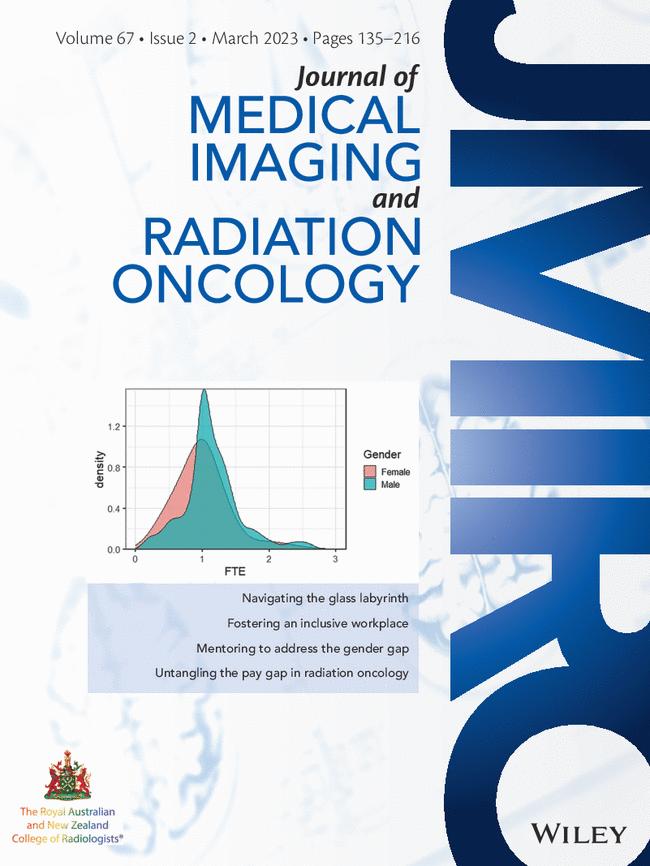
10 minute read
Inside News June 2023
by RANZCR
Why Sex And Gender Diversity Are Important In Clinical Research
As clinical practice shifts from being disease-centred to patient-centred in its pursuit of personalised medicine, recognition of sex and gender diversity becomes especially important. This should therefore also be reflected in the clinical research being conducted to ensure that medical studies fully represent diverse populations and hence improve clinical healthcare. A special issue of the Journal of Medical Imaging and Radiation Oncology (JMIRO), the official journal of the Royal Australian and New Zealand College of Radiologists (RANZCR), focuses on gender and diversity, and highlights the rationale behind its decision to adopt the Sex and Gender Equity in Research (SAGER) guidelines.
SEX AND GENDER EQUITY IN RESEARCH (SAGER) GUIDELINES
Sex and Gender Equity in Research (SAGER) guidelines were developed in 2016 and are a valuable tool for authors and editors to help them include the variables of sex and gender in their research. The guidelines have been widely endorsed and encourage authors to exercise care in their use of terminology while providing a comprehensive procedure for reporting sex and gender information in their study design, data analyses, results and interpretation of findings.
The SAGER guidelines have now been adopted by the JMIRO and will be included in authors’ instructions and in briefings to reviewers, associate editors and guest editors. RANZCR encourages all members to follow these guidelines: http://ow.ly/MnUZ50MK6pO
The March 2023 issue of JMIRO includes original articles, review pieces and viewpoints on gender and diversity, which cover a wide range of areas, including gender analysis in radiology professions, patients, workplaces and working conditions.
DIVERSE PATIENTS
Historically, medical studies have underrepresented female participants and most research data have been collected from males and generalised to other genders. While the needs and concerns of transgender and genderdiverse patients have begun to be addressed, many clinicians continue to be underinformed about the health and wellbeing needs of trans and gender diverse individuals, resulting in problems with service provision. More attention therefore needs to directed to this group in research, policy and practice. A recent study in Academic Radiology outlined how a radiologyoriented transgender curriculum showed success in increasing radiologists’ awareness about transgender patients. The researchers of this study noted ‘By understanding the needs of transgender patients, radiology residents can help promote an equitable and inclusive environment in radiology departments.’
The guidelines have been widely endorsed and encourage authors to exercise care in their use of terminology.“
DIVERSE CLINICIANS
Gender diversity in academic and leadership positions in radiology internationally is equally important. Factors leading to the gender gap include a lack of role models and mentors, unconscious biases, other societal barriers and generational changes. A number of recent studies have quantified the lack of gender diversity in radiology.
RANZCR member Dr Glen Lo has contributed this editorial to the special issue of JMIRO.
TO JMIRO GENDER AND DIVERSITY SPECIAL ISSUE EDITORIAL – BY DR GLEN LO
Medicine has changed a lot since the turn of the most recent century; it’s now been 22 years since the clocks ticked over into the ‘future’ that was the near horizon for the Australian television show, Beyond 2000. I entered medical school in 1997 feeling utterly alone and without representation; I’d come from a single-parent family and attended a public school – only four graduates went to university. I was also mixed race and gay. It was not uncommon in the 1990s to hear of gay men being refused hospital entry to visit a partner because the rules dictated ‘family only’ and did not recognise same-sex relationships. Australia only recognised my marriage certificate in 2017, three years after I got married in Canada. I had not intended to be a doctor. I hated going to the doctor because they made you wait, without apology, and made wrong assumptions. I didn’t trust doctors, and I didn’t like to hear of people like me being excluded from hospitals because of who they loved. With my teenage reasoning, the only solution was to become a doctor myself and re-write hospital rules.
This special issue of JMIRO is the second in a series that examines diversity, equity and inclusion: in our colleagues, our patients and ourselves. This issue examines gender diversity, specifically representation of women authored by women, acknowledging that there is a void of data regarding the presence, contributions and workplace experiences of gender non-binary and transgender providers. It also offers our readership personal and institutional tactics on how to fully include sexual and gender minorities. Future special issues will address racial and cultural diversity, as well as hearing from Aboriginal and First Nations voices from Australia and New Zealand Aotearoa. Disability inclusions are not yet planned but are also important. Central to these special issues is listening to those with lived experience and taking direction from them. The health inequalities and inequities experienced by our patients and the workplace inequalities experienced by healthcare providers are a by-product of the common culture in which we live. Solutions to both sets of problems are intersectional.1 We all have a role.
Sex and gender are two related but different variables, and, in a scientific journal such as JMIRO, it is critical for all RANZCR fellows to have a working understanding of how to ask research participants questions on gender identity to accurately collect and report data. The Australian Bureau of Statistics sets standards2 for four variables:
1. Sex
2. Gender
3. Variations of sex characteristics
4. Sexual orientation
WOMEN
To date, RANZCR has only collected fellows’ gender data as a binary categorical variable. This issue’s papers on gender diversity highlight the under-representation of women in radiology. Moriarty et al. report on gender imbalance in interventional radiology; Yap et al. report on radiation oncology gender pay gap; Lim et al.
examine gender in workforce planning; Hayter and Ayesa report on female representation in subspeciality interest groups; Batumalai et al. report on assumed gender trends in first and senior authors in JMIRO publications; Hesselberg et al. report on gender diversity and leadership in radiation oncology. Georgousakis provides an account on mentoring for women.
GENDER AND SEXUALITY DIVERSITY
Sexual minorities are often lumped together in broadbrush approaches that use increasingly long acronyms that are as much a word salad for readers as the diversity of people that they conglomerate. For example, attempts to include nonheterosexual human
It is critical for all RANZCR fellows to have a working understanding of how to ask research participants questions on gender identity to accurately collect and report data.
sexual identities can be made maximally inclusive but unworkably complex by the acronym ‘LGBTQQIP2SAA+’ (Lesbian, Gay, Bisexual, Transgender, Questioning, Queer, Intersex, Pansexual, Two-Spirit, Androgynous, Asexual +). 3 The two articles in this special issue addressing diversity of sexuality have chosen to report on LGBTQIA+ people: Bird et al. offer suggestions for individuals and institutions on workplace inclusivity; Chapman et al. report on a qualitative study on gaps in knowledge for radiologists and radiation oncologists in caring for LGBTQIA+ patients. RACS and RANZCOG are both ahead of RANZCR in policies and actions around diversity, inclusion and equity, and the paucity of invited submissions for a special issue on diversity reflects this.
However, RANZCR has now literally joined the march forward with the Board’s endorsement to participate in a combined medical speciality college entry in the Sydney World Pride 2023 Mardi Gras Parade, organised by the bi-national network of specialists and medical students, Pride in Medicine.
JMIRO
How is JMIRO changing in the context of these special issues? The Medical Journal of Australia has reported on gender inequity for women in medicine and now recommends that authors of research published in the MJA follow the Sex and Gender Equity in Research (SAGER) guidelines. 5 The American Journal of Radiology has made recommendations for more inclusive language in figure legends and gender descriptors.6 It would seem an easy solution to simply adopt any suggested inclusive language alternative. But, using new blanket terminology without context, consultation or consent, can quickly backfire, especially if people perceive erasure. Women were dehumanised when the Lancet Sep 2021 cover Tweet quoted ‘bodies with vaginas’ without context, and the cover Tweet went viral. My skin crawls when reading research papers about people like me, referred to as ‘CaLD’ (culturally and linguistically diverse, but pronounced ‘cold’) or ‘MSM’ (men who have sex with men, not mainstream media); I didn’t choose these names. In studies including only participants who have had the opportunity to confirm that they identify as women, then female-gendered language terms recognising womanhood are expected. Assumptions on participant gender are, however, exclusionary and result in identity erasure. There is no easy solution or shortcut from asking the right questions at the right time.

HOW THIS AFFECTS EVERY MEMBER, WHETHER YOU REALISE IT OR NOT
Attempts at change may get shot down immediately because of imperfection; it’s easy to reject any solution that doesn’t immediately solve all problems. It is also easy to speak over and alienate a group of people, if advocating without their engagement or consent. Whop et al. 7 describe this concept well in ‘The Blackfulla test’ for active representation in Indigenous health research. Every member of RANZCR, our colleagues, and our patients all deserve respect, to be counted, and to have a voice. We need to be precise and correct in our data collection and reporting, as we work towards optimising health outcomes. We earn our patients’ trust by respecting their autonomy and this includes affirming their identity and who will visit them in hospital. The assurance of being able to visit a hospitalised same-sex spouse shouldn’t be limited to those who have attained the privilege and authority of a medical degree. However, those who do possess the privilege and authority inherit the responsibility to identify and dismantle health inequities at the coalface, today. I welcome constructive engagement in crafting durable solutions that will serve us far beyond the near horizon.
Dr Glen Lo
1. Anderson CTM. Taking Back our voices — #HumanityIsOurLane. N Engl J Med 2020; 383: 1609– 11.
2. Statistics AB of. Standard for Sex, Gender, Variations of Sex Characteristics and Sexual Orientation Variables [Internet], 2020. [Cited 27 Sep 2022.] Available from URL: https://www.abs.gov.au/statistics/ standards/standard-sex-gender-variations-sexcharacteristics- and-sexual-orientation-variables/ latestrelease
3. Rioux C, Par_e A, London-Nadeau K et al. Sex and gender terminology: a glossary for gender-inclusive epidemiology. J Epidemiology Community Health 2022; 76: 764–8.
4. Dorrigan A, Zuccala E, Talley NJ. Striving for gender equity at the medical journal of Australia. Med J Aust 2022; 217: 138–9.
5. Heidari S, Babor TF, Castro PD, Tort S, Curno M. Sex and gender equity in research: rationale for the SAGER guidelines and recommended use. Res Integr Peer Rev 2016; 1: 2.
6. Doo FX, Zavaletta V, Carroll EF, Ellis KL, Rosenkrantz AB. Turning a page in the yellow journal: figure legends and gender-inclusive patient descriptors. Am J Roentgenol 2022; 219: 1–2.
7. Whop DL, Watego AD, Watego C. The Blackfulla Test: 11 reasons that Indigenous health research grant/ publication should be rejected [Internet]. [Cited 21 Sep. 2022.] Available from URL: https://indigenousx.com.au/ the-blackfulla-test-11-reasons-that-indigenous-healthresearch- grant-publicationshould-be-rejected/

